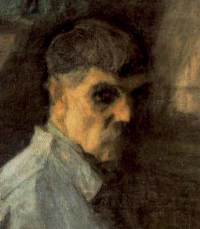HOLLÓSY, Simon
(1857, Máramarossziget - 1918, Técső)


Painter, one of the greatest Hungarian representatives of 19th century naturalism and realism. Hollósy, who came from an Armenian family in Máramarossziget, learnt to paint in Budapest and Munich where he painted "Corn Husking" in 1885, which brought him success in Hungary and abroad.
He criticized training at the Academy and founded a private school in 1886 where he gathered young talents around him who were interested in realistic protrayal. He opened the way to new styles by relying on his personality and by pointing out the merits of French pictures (Courbet) exhibited in Munich. He abandoned the academic style in order to follow new trends in French painting.
Encouraged by István Réti and János Thorma, his pupils and friends, he spent the summer of 1896 in Nagybánya with his school, which played an important role in Hungarian painting as the cradle of the Nagybánya school. He soon settled down in Nagybánya. With its style (sunny landscapes), his school determined Hungarian painting for decades. Leaving the Nagybánya colony in 1901, he spent the summers in Técső with his students from 1902. During winters he was in Munich to run his school there.
He was not productive as an artist: he was in search of atmospheres and his productivity was confined to teaching. His large scale plan of "Rákóczi March" with a lot of figures got as far sketches because he kept on changing his mind. The landscapes painted in Técső include "Landscape in Técső", "Landscape with Stacks and Sunset with Stacks", where he applied elements of plein air and impressionism. His self-portrait (1918) is one of his most harrowing pictures.
